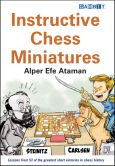
Instructive chess miniatures by Alper
Efe Ataman
2016
Gambit
Publications Ltd
http://www.gambitbooks.com
E-mail info@gambitbooks.com
128 pages
Price €13,50
ISBN 978-1-910093-88-7
The well known Fide master
from Turkey presents in this wonderful made Gambit book,a
collection of 53 greatest short chess victories of all time.
Starting with the legendary Evergreen game,Anderssen – Dufresne
from the year 1852 and ends with the famous blits game, So – Kasparov
St.Louis blitz
2016,where Kasparov later explained” It reminded me of the games Morphy
played with amateurs…I was an amateur in this game!”
By the way Wesley So used little more than two minutes on this
entire brilliant game! Included in this book are important key themes
as for
example attacking the castles king,where I would like to end with
the following shortcut on the
white king: Hammer,Jon Ludvig (2074) - Carlsen,Magnus (2450) [B07] Wch
U14 Chalkidiki (1), 23.10.2003
1.Nf3 d6 2.d4 Nf6 3.Nbd2 g6 4.e4 Bg7 5.Bd3 0-0 6.0-0 Nc6 7.c3 e5 8.h3
Nh5 9.dxe5 Nf4 10.Bb5 Nxe5 11.Nxe5 Qg5 12.Ng4 Qxb5 13.Nb3 Ne2+
14.Kh1 Bxg4 15.hxg4 Rae8 16.Be3 Rxe4 17.Re1 Qh5+ 0-1,and wonder boy
Magnus was that time only 13 years old!
Conclusion: This book holds an
outstanding collection short victories!
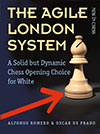
The Agile London
System
A Solid but Dynamic Chess Opening Choice for White
by Alfonso Romero Holmes & Oscar de Prado Rodriguez
New in Chess
http://www.newinchess.com/
335 pages
Price $ 26.95
ISBN: 978-90-5691-689-3
The two chess professionals Grandmaster Alfonso Romero Holmes
and his companion FIDE master Oscar de Prado Rodriguez, provide the
reader with a impressive
made move to move openings book on the London
System, which runs with the moves 1.d4 Nf3 and Bf4.
The London System is simple a set of solid lines where white quickly
develops his dark squared bishop to f4 and than bolsters his centre
with c3
and e3.
The Pereyra Attack is related to the Argentina chess champion Manuel
Pereyra Puebla, who preferred to play a set-up with 1.d4 e6 2.Nf3 Nf6
3.Bf4 d5
4.e3 Bd6 5.Ne5,and this all is considered is chapter 13.
The main basis of this book is a Hugh collection of 64 games, exercises
and extra included illustrative games,all packed in 13 intensive
chapters.
Covered are London System versus the Grünfeld,King’s
Indian,Queen’s Indian,Benoni,Dutch,Slav and various lines as for
example the Polish Defence
A fine example of modern play is model game 18: Payen,Arnaud (2325) -
Hansen,Eric (2557) [A48]
Cappelle op 29th Cappelle-la-Grande (1), 23.02.2013
1.d4 Nf6 2.Nf3 g6 3.Bf4 Bg7 4.e3 0-0 5.Be2 d6 6.0-0 c5 7.c3 Qb6 8.Nbd2
Bf5 9.Nc4 Qc7 10.h3 Nbd7 11.a4 Rac8 12.Bh2 Be6
13.Ncd2 cxd4 14.exd4 Qb6
15.Qb1 Rfe8 16.a5 Qc7 17.Re1 Bh6 18.Bd3 Bd5 19.Re2 e5 20.dxe5 dxe5
21.Qe1 Qc6 22.Ne4 Nxe4
23.Bxe4 Bxe4 24.Rxe4 f6 25.Nd4 Qd5 26.Nc2 Nc5
27.Re2 Nd3 28.Qb1 Rcd8 29.Ne1 Nc1 30.Rc2 Nb3 31.c4 Qe4 32.Rc3 Qxb1
33.Rxb1 Nxa5 34.b4 Bd2 35.Ra3 Nxc4 36.Rxa7 Rd7 37.g4 Red8 38.Kg2 b6
39.Rxd7 Rxd7 40.Nf3 Kf7 41.b5 Ba5 42.Rc1 Rc7
43.Rd1 g5 44.h4 h5 45.hxg5
hxg4 46.Nh4 fxg5 47.Nf5 Kg6 48.Ng3 Nd2 49.Nf1 Nxf1 50.Bxe5 Re7 51.Rd6+
Kf5 52.Bd4 Nd2
53.Rf6+ Ke4 54.Bxb6 Bxb6 55.Rxb6 Kf5 56.Rb8 Re1 57.Rf8+
Kg6 58.Rg8+ Kf6 59.Rh8 Rb1 60.b6 Nf3 61.Rh1 Nh4+ 62.Kh2 Rxb6
63.Kg3 Kf5
0-1,covered with nearly 7 pages of highly instructive text!
The London System is one of the safest and most solid method of
handling the white pieces,and is flexible enough to be played under all
tournament conditions and even with correspondence chess!
Conclusion: Very important reference
work on the London System!
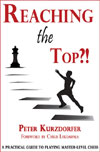 Reaching the Top?!
Reaching the Top?!
A Practical Guide to Master-Level Chess
by Peter Kurzdorfer
2015
Russell Enterprises
304 pages
Price € 22,95
ISBN: 978-1-941270-17-2
Reaching the top is a practical guide from the American chess Master
Peter Kurzdorfer how to reach the magical goal of chessmaster,or how
to
convert your chess knowledge to the so wanted 2200 ELO level.
This all is readable done with topics as Learning From Past Mistakes
,Choose Openings to Suit Your Style,Handling Material
Inequality,Practical
Endgames,How Sound Do Your Openings Need to Be?
When Things Go Terribly Wrong, Overcoming Difficulties and How to Win.
A large amount of material come from the personal experiences of
Peter Kurzdorfer and that makes all even more interesting.
But first some words from the author himself: When I began to play, all
this book learning did not immediately translate into wins or a high
rating.
Something was missing. I needed the experience of playing. So I
played a lot. And still something was missing. I played the strongest
competition
I could find and analysed the games with my opponents and
by myself afterwards. And still something was missing. I was not
“getting it.”
I had trouble calculating reliable variations over the board, so began
playing correspondence games where I could look at each position I
analysed
on a chessboard and so see it clearer.
This did strengthen my play, but it was not enough. I played blindfold
games so I could learn to see these positions in my head during a
tournament game.
There are many games from Peter Kurzdorfer in this book but he has no
problems analysing games that did not work so well out for him,as for
example the
following game against six time US Champion Walter Browne:
Browne,Walter S (2530) - Kurzdorfer,Peter [D34]
New York op New York (1), 1985
1.d4 d5 2.c4 e6 3.Nc3 c5 4.cxd5 exd5 5.Nf3 Nc6 6.g3 Nf6 7.Bg2 Be7 8.0-0
0-0 9.Bg5 Be6 10.dxc5 Bxc5 11.Rc1 Be7 12.Nd4 h6 13.Bf4 Qb6
14.Nxe6 fxe6
15.e4 d4 16.e5 Nxe5 17.Bxe5 dxc3 18.bxc3 Rad8 19.Qe2 Nd5 20.Rb1 Qc6
21.c4 Qa6 22.Rb5 Bf6 23.cxd5 Bxe5 24.dxe6 Bf6
25.Bxb7 Rd2 26.e7 1-0.
This work is overloaded with instructive tips!
Conclusion: This book truly helps you
to become a master in chess!
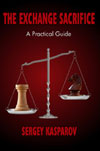 The Exchange Sacrifice
The Exchange Sacrifice
A Practical Guide
by Sergey Kasparov
2015
Russell Enterprises
252pages
Price € 22,95
ISBN: 978-1-941270-22-6
The well known Grandmaster Sergey Kasparov handles at the hand of a
small 200 instructive games the so complicated strategies of exchange
sacrifices, usually
these techniques are rarely covered ,so to see a
complete study on this subject is a novelty.
All techniques are packed in readable chapters as Domination,
Fighting for the Initiative, Utilizing an Advantage, Launching an
Attack against
the King, Reducing Your Opponent’s Offensive Potential,
Destroying a Pawn Chain, Building a Fortress and Activating Your Bishop.
Every chapter of this book is overloaded with creative master pieces as
for example from the greatest chess player of all time,Garry Kasparov:
Kramnik,Vladimir (2758) - Kasparov,Garry (2851) [D23]
Linares 17th Linares (8), 08.03.2000
1.Nf3 Nf6 2.c4 c5 3.g3 d5 4.d4 dxc4 5.Qa4+ Bd7 6.Qxc4 Bc6 7.dxc5 Bd5
8.Qa4+ Bc6 9.Qc4 Bd5 10.Qc2 e6 11.Bg2 Be4 12.Qc4 Bd5
13.Qh4 Bxc5 14.Nc3
Bc6 15.0-0 Be7 16.Rd1 Qa5 17.Bd2 Nbd7 18.g4 h6 19.Qg3 Qa6 20.h4 Qc4
21.Bf4 Qb4 22.a3 Qxb2 23.Nd4 g5
24.Nxc6 gxf4 25.Qd3 bxc6 26.Bxc6 0-0
27.Bxa8 Ne5 28.Qd4 Rxa8 29.Qxe5 Rc8 30.Rac1 Nd5 31.Nxd5 Qxe5 32.Nxe7+
Kg7 33.Rxc8 Qxe2
34.Rg8+ Kf6 35.Rd7 Qe1+ 36.Kg2 Qe4+ 37.Kh2 Qc2 38.Kg2
Qe4+ 39.Kh2 Qc2 40.g5+ hxg5 41.Rxg5 Qxf2+ ½-½,
Pleas see that white has thrown all his forces into attack and left his
king defenceless. He does not have time for the deadly check Ne7-g8.
All games are well covered with highly instructive text and I can only
end with the words,this is honestly a very instructive written
middle game book!
Conclusion: Brilliant work!
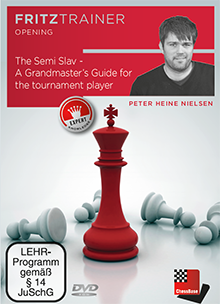
TrainingOpeningFritztrainer
The Semi-Slav
by GM Peter Heine Nielsen
http://www.chessbase.com
E-Mail info@chessbase.com
Price Euro 29.90
System requirements:Pentium-Processor
at 300 Mhz or higher, 64 MB RAM,
Windows XP, Windows
Vista, Windows 7, DVD drive, mouse, soundcard
The Semi-Slav belongs to one of the most played lines and it
runs with the moves:
1.d4 d5 2.c4 c6 3.Nf3 Nf6 4.Nc3 e6,but as we can see on this DVD it has
various move orders.
The well known chess crack Grandmaster Peter Heine Nielsen does not
only explain in a impressive over 7 hours, all strategies and important
key moments
but provides the user also with a lot of latest played developments, as
for example in following the Botvinnik line:
Botvinnik [D44]
1.d4 d5 [1...Nf6 2.c4 e6 3.Nf3 d5 4.Nc3 dxc4 5.e4 Bb4 6.Bg5 c5 7.Bxc4
cxd4 8.Nxd4 Qa5 9.Bd2 0-0 10.Nc2 Bxc3 (10...Nc6) 11.Bxc3 Qg5] 2.c4 c6
3.Nc3 Nf6 4.Nf3 e6 5.Bg5 dxc4 6.a4 [6.e4 b5 7.e5 h6 8.Bh4 g5 9.Bg3 a)
9.exf6 gxh4 10.Ne5 Nd7 (10...Qxf6 11.a4 Bb7 (11...a6 12.Be2 Nd7 13.Nxc6
Bb7) 12.axb5 cxb5 13.Bxc4 bxc4 (13...a6 14.Nxb5 axb5 15.Bxb5+ Kd8
16.Rxa8 Bxa8 17.Qa4 Bd6) 14.Qa4+) 11.Nxf7 Kxf7 12.Qh5+ Kg8 (12...Kxf6
13.Qxh4+) 13.Qg6+;
b) 9.Nxg5 hxg5 (9...Nd5 10.Nxf7 Qxh4 11.Nxh8 Bb4) 10.Bxg5 Nbd7
(10...Be7 11.exf6 Bxf6 12.Bxf6 (12.Be3) 12...Qxf6 13.g3 Bb7 14.Bg2 Na6)
11.g3 (11.exf6 Bb7 12.g3 c5 13.d5) 11...Bb7 (11...Rg8 12.h4 Rxg5
13.hxg5 Nd5 14.g6 fxg6 15.Qg4 Qa5 (15...Qe7 16.Bg2 Kd8 17.Qxg6) 16.Bg2
Nxc3 17.Kf1) 12.Bg2 Qb6 13.exf6 0-0-0 14.0-0 c5 15.d5 b4 16.Rb1 (16.Na4
Qa6 (16...Qb5 17.a3 Nb8 (17...exd5 18.axb4 d4) 18.axb4 cxb4 19.Be3 b1)
19.Qg4 Bxd5 20.Rfc1 Nc6 21.Bxd5 Rxd5 22.Rxc4 Rxg5 23.Qd4 Kb8 (23...Rd5
24.Qxa7 Qxc4) 24.Rxc6 Rxg3+ (24...Qxc6 25.Qf4+) 25.fxg3 (25.hxg3 Qxc6)
25...Qxc6 26.Rd1 Qc7 27.Qd8+ (27.Kf1 Rh5 28.Qd8+ Qc8; 27.b3 Kc8 28.Qe4
Kb8) 27...Qxd8 28.Rxd8+ Kc7; b2) 19.Qd4 Nc6 20.dxc6 Rxd4 21.cxb7+ Kc7
(21...Kb8 22.Be3 e5 23.b3 (23.Nc3 bxc3 24.bxc3 Bh6 25.Rfb1 Rd1+ 26.Rxd1
Bxe3 27.fxe3) 23...c3 24.Rfd1 Bh6 (24...c2 25.Rxd4 exd4 26.Bf4+)
25.Bxd4 exd4 26.Rxd4 c2 27.Rc4 Qxc4 28.bxc4 Rd8 (28...c1Q+ 29.Rxc1 Bxc1
30.Nc5) 29.Bf3 c1Q+ 30.Rxc1 Bxc1 31.Nc5 Rd6 32.Bd5 a5) 22.Be3 e5 23.Nc3
bxc3 24.bxc3 Bh6 25.cxd4 Bxe3 26.Rfb1 Qd7 27.b8R Rxb8 28.Rxa7+;
19...Bxd5 20.Bxd5 Rxd5 21.Qe2 Nc6 22.Rfc1 Ne5) 17.a3 Bxd5 18.Bxd5 Ne5
19.axb4 Rxd5 20.Qe2 cxb4 21.Nc3 Ra5 0-1 (21) 22.Rxa5 Qxa5 23.Ne4 Nd3)
16...Qa6 (16...bxc3 17.bxc3 Qa6 18.Rxb7) 17.dxe6 Bxg2 18.e7 Bb7
(18...Bxf1 19.Qd5 (19.Kxf1 Bxe7 (19...Qc6 20.exd8Q+ Kxd8 21.Nd5 Rxh2
22.Kg1 Rh8 23.Bf4 Kc8 24.Qf3 Kb7 25.Rd1 Bh6 26.Qh5 Bg7) 20.fxe7 Rdg8
21.Ne4 Rxg5 22.Nxg5 Re8 23.Qd5 Rxe7 24.Kg1 f6 25.Ne4 Kc7 26.Nd2 Qxa2
27.h4 Re5 28.Qxc4 Qxc4 29.Nxc4 Re8 30.Ra1 Nb6 31.Ne3 Ra8 32.Ra5 Kc6)
19...Bxe7 20.fxe7 Bd3 21.exd8Q+ Rxd8 22.Ne4 Bxb1 23.Nd6+ Kc7 24.Bf4 Kb6
25.Nxc4+ Kb5 26.Nd6+ Kb6 27.a4 bxa3 28.Nc4+ Qxc4 (28...Kb5 29.Nxa3+)
29.Qxc4 a2) 19.exd8Q+ Kxd8 20.Ne2 Qc6; ] 6...Bb4 [6...b5 7.axb5 cxb5
8.Nxb5 Qb6 9.Nc3 Qxb2 10.Bd2 Nd5] 7.e4 Qa5 [7...c5 8.Bxc4 cxd4 9.Nxd4
h6 10.Bh4 (10.Bf4 Nxe4 11.0-0) 10...g5;
7...Bxc3+ 8.bxc3 Qa5 9.Qc2 (9.e5 Qxc3+ a) 9...Ne4 10.Bd2 (10.Rc1 Nxc3
(10...Nd7 11.Be3 (11.Nd2 Nxg5 (11...Nxc3 12.Nxc4 Nxd1+ 13.Nxa5 Nb2)
12.h4) ) 11.Qd2) ;
b) 9...Nd5 10.Bd2 Nxc3 11.Qc2; 10.Bd2) 9...Nxe4] 8.Bd2 c5 9.Bxc4 cxd4
10.Nxd4 0-0 11.Nc2 [11.0-0] 11...Nc6 12.Nxb4 Qxb4,yes these lines are
quite massive.
Included is a extra database of 59 entries and a collection self tests
to see if you hae learned from Peter Heine Nielsen instructive lessons!
Conclusion: One of those super made
ChessBase GM DVD’s!
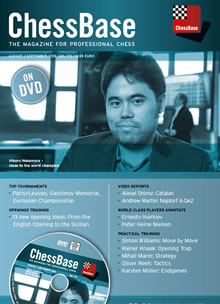
ChessBase Magazine issue 173
2016
August/September
http://www.chessbase.com
E-Mail
info@chessbase.com
ISSN 1432-8992
Price Euro 19.95
The master file on this DVD,
the so called tournament file holds 273 entries where a small 19 of
them are more than excellent analysed:
A fine example of this all is the following heavy weight : Dominguez
Perez,Leinier (2723) - Ivanchuk,Vassily (2710) [C70]
Capablanca Memorial Elite 51st Varadero (5), 13.06.2016
[Stohl,I]
1.e4 e5 2.Nf3 Nc6 3.Bb5 a6 4.Ba4 d6 The Ruy Lopez is not only the
Berlin, Marshall and the respective anti-systems! Ivanchuk opts for the
deferred Steinitz, a time-honoured system which has already featured in
his previous practice, but is relatively rare nowadays.
5.0-0 One of the two main moves. Let's check the alternatives briefly:
[5.d4 is the main continuation on move 4 against the Steinitz proper,
here it's not too effective due to 5...b5 6.Bb3 Nxd4 7.Nxd4 exd4 8.Bd5
a) 8.Qxd4?? c5 9.Qd5 Be6 10.Qc6+ Bd7 11.Qd5 c4-+; b) 8.c3 dxc3 9.Qd5
(9.Nxc3 Nf6 10.e5 dxe5 11.Bxf7+ Ke7 is at best unclear) 9...Be6 10.Qc6+
Bd7 11.Qd5= is a way to avoid a fight.; 8...Rb8 9.Bc6+ (9.Qxd4 Ne7!? .
10.0-0? c6 11.Bb3 c5-+) 9...Bd7 10.Bxd7+ Qxd7 11.Qxd4 Nf6 12.0-0 Be7
13.Rd1 Qc6 14.Nc3 0-0 15.Bg5 Rfe8 16.a3 h6 17.Bd2 a5 18.Qd3 b4 19.axb4
axb4 20.Nd5 Nxd5 21.exd5 Qb5 22.c4 bxc3 23.Bxc3 Bf6= Mamedov,R
(2651)-Adhiban,B (2547) Moscow 2013;
5.c4 is the Duras setup, but Black can delay (or even stop) d4 with
5...Bg4! (<5...Bd7 6.d4 exd4 7.Nxd4²) 6.h3 a) 6.d4 Bxf3 7.gxf3
exd4 8.Bxc6+ bxc6 9.Qxd4 Ne7!?÷ /³(9...Qf6=) ; b) 6.Nc3 Nf6
7.d3 Be7 (7...Nd7!?) 8.h3 Bxf3 9.Qxf3 0-0 can easily transpose to the
same position.; 6...Bxf3 7.Qxf3 Nf6 8.Nc3 Be7 9.d3 0-0 10.Bxc6 bxc6
11.0-0 Nd7 12.Be3 g6 13.Qd1 Qb8 14.Qd2 Bf6= 15.g3 Bg7 16.f4?! exf4
17.gxf4 f5 18.d4 fxe4 19.Nxe4 Nf6f Brkic,A (2575)-Short,N (2707) Bastia
rpd 2012;
5.Bxc6+ bxc6 6.d4 gives Black a choice: Black can also play more
actively with 6...exd4!? (6...f6 7.Be3 Ne7 (7...g6!? is also viable, as
introduced already by the classics: 8.Qd2 Bg7 9.Nc3 Bd7 10.0-0 Ne7
11.h3 0-0 12.Rad1 Qb8 13.b3 Qb7 14.Bh6 Rad8 15.Bxg7 Kxg7 16.Nh2 Qb4
17.Qe3 Rde8 18.Ne2 exd4 19.Rxd4 Qb6 20.Qd2 c5 21.Rd3 Qb4 22.c4 Qxd2
23.Rxd2 Bc6= Romanovsky,P-Capablanca,J Moscow 1935) 8.c4 Ng6 9.Nc3 Be7
10.0-0 0-0 11.h3 (11.Qa4 Bd7 12.c5 Kh8 13.Rad1 Qe8 14.h3 d5!" 15.dxe5?
fxe5 16.Ne2 d4 17.Bd2 Rxf3 18.gxf3 Nh4 19.Qa3 Bxh3-+ ,, Karjakin,S
(2732)-Grischuk,A (2711) Odessa rpd 2008) 11...Bd7 12.Ne2 f5 13.exf5
Bxf5 14.Ng3 exd4 15.Nxf5 dxe3 16.Nxe3 Qd7 17.Rc1 Rf4 18.g3 Rf7 19.Ng4
Bf6 20.Rc2 Rd8= Brodsky,M (2559)-Yandemirov,V (2483) St Petersburg
2003/ Valery Yandemirov is a big fan of the deferred Steinitz.) 7.Qxd4
(7.Nxd4 c5 8.Nf3 (8.Ne2 Nf6 9.Nbc3 Bb7 10.f3 Rb8 11.0-0 g6 12.Be3 Bg7
13.Qd2 0-0 14.Rad1 Re8 15.Nf4 Qe7 16.Rfe1 Qf8 17.b3 Re5 18.Nd3 Ree8
19.Nf4 Re5 20.Nd3 ½, Chiburdanidze,M (2355)-Hort,V (2585)
Dortmund 1983) 8...Bb7 9.0-0 Nf6 10.Nc3 Be7 11.e5 dxe5 12.Nxe5 Qd4
13.Qe2 0-0 14.Rd1 Qh4 15.Nf3 Qg4 16.h3 Bxf3 17.Qxf3 Qxf3 18.gxf3 Bd6
19.Be3 Rfe8 20.Nd5 Re6 21.c4 Rb8 22.b3 Nh5÷ Sebag,M
(2504)-Fedorchuk,S (2654) Mulhouse 2011) 7...c5 (7...Nf6 8.0-0 Be7 9.c4
0-0 10.Nc3 Bg4 11.Qd3 Bxf3 12.Qxf3 Nd7 13.Qd3 Bf6 14.Be3 Re8 15.f3 Be5
16.Qd2 Qf6 17.Rac1 Qe6 18.b3 f5 19.Bd4 a5 20.Bxe5 Qxe5 21.exf5 Qxf5
22.Ne4 Nc5 23.Nxc5= ½, Filippov,A (2615)-Safarli,E (2649)
Kocaeli 2014) 8.Qd3 Be7 9.0-0 Bb7 10.Re1 Nf6 11.c4 0-0 12.Nc3 Re8
13.Rb1 Qd7 14.h3 Rad8 15.b3 h6 16.Bf4 Bf8 17.Bh2 Re6 18.Re3 Rde8
19.Rbe1 g6 20.Nd5 Nxd5 21.exd5 Rxe3 22.Rxe3 c6" Illingworth,M
(2486)-Short,N (2671) Ballarat 2016;
5.c3 is the other main alternative, which is even a tad more popular,
than the text move: However, White must also seriously reckon with the
more enterprising Siesta variation: 5...f5!? (5...Bd7 6.d4 g6 7.0-0 Bg7
is the restrained approach: 8.Re1 (8.h3 Nf6 (8...h6 9.Be3 Nge7 10.Nbd2
0-0 11.dxe5 dxe5 12.Bc5 Re8 13.Re1 b6 14.Ba3 Na7 15.Bxd7 Qxd7 16.Nc4
Qe6 17.Ne3 Nb5 18.Bxe7 Rxe7 19.Qa4 Nd6 20.Qc6 Rc8 21.Rad1 Kh7 22.Rd2
Ne8 23.Qb7 Nd6 24.Rxd6!? cxd6 25.Qxa6© /², Caruana,F
(2774)-Ivanchuk,V (2755) Thessaloniki 2013) 9.Re1 0-0 10.Nbd2 Re8
11.Bc2 Qe7 12.Nf1 Qf8!? 13.Ng3 Rad8 14.d5 Ne7 15.Nh2 Bh6 16.Qf3 Bxc1
17.Raxc1 Qg7 18.Qe3 Nh5!? 19.Nxh5 gxh5 20.Kh1 f5 21.exf5 Bxf5 22.Bxf5
Nxf5 23.Qd3 Rf8" Caruana,F (2774)-Andreikin,D (2713) Moscow 2013)
Perhaps a more promising try is Carlsen's 8...Nf6 (8...Nge7 9.Be3 0-0
10.d5 Nb8 11.Bxd7 Nxd7 12.c4! (The immediate 12.Nfd2 f5 13.f3 allows
13...Rf7!? 14.c4 Qf8 15.Nc3 Bh6 16.Bf2 Bxd2 17.Qxd2 f4 18.b4 g5 19.c5
Rg7 20.Qe2 Nf6" Stehno,P (2366)-Radulski,J (2502) Brno 2005, with
typical KID play) 12...h6 (12...f5 13.Ng5 f4 14.Bc1 Nc5 15.b4f) 13.Nfd2
is a recommendation by Jansa, the KID structure without the
light-squared bishops is advantageous for White after 13...f5 14.f3 c5
(14...f4 15.Bf2 g5 16.Nc3 Ng6 17.b4 Nf6 18.c5 h5 19.Nc4 g4 20.Rb1 Rf7
21.b5 Bh6 22.b6± Silva,A (2530)-Har Even,A (2532) email 2008)
15.Nc3 Qc7 16.Rb1 Rfb8 17.Qe2 f4 18.Bf2 g5 19.b4 b6 20.Rb2 Bf6 21.Reb1
Nc8 22.g4 Kg7 23.Kg2 Kg6 24.a3² ?/±, Polgar,J
(2595)-Spassky,B (2565) Budapest 1993) 9.d5 (9.Bxc6 Bxc6 10.dxe5 Nxe4
11.exd6 Qxd6 12.Qxd6 cxd6 13.Nfd2 0-0 14.Rxe4 Bxe4 15.Nxe4 Rfe8 16.Nbd2
d5 17.Ng3 Re1+ 18.Ngf1 d4 19.cxd4 Rc8 20.Nb3 Bxd4 21.Nxd4 Rcxc1 22.Rxc1
Rxc1© Yagupov,I (2555)-Novikov,M (2545) Tula 2006) 9...Ne7
10.Bxd7+ Nxd7 11.Be3 Ng8!? instead, Black equalised after 12.c4 Bh6
13.Nc3 Bxe3 14.Rxe3 Ngf6 15.b4 0-0 16.Rc1 Qe7 17.Nd2 a5 18.a3 axb4
19.axb4 Nb6 20.h3 Rfc8 21.Ra1 Rxa1 22.Qxa1 Ra8 23.Qb2 Qe8 24.Qc2 c6
25.Kh2 Qc8 26.dxc6 Qxc6= Karjakin,S (2769)-Carlsen,M (2844) Wijk aan
Zee 2016) 6.exf5 (6.d3 Nf6 seems too timid: 7.0-0 Be7 8.Re1 0-0 9.Bb3+
Kh8 10.Ng5 Qe8 11.Ne6 Bxe6 12.Bxe6 fxe4 13.dxe4 Qg6 14.Bf5 Qf7 15.Qf3
Radulski,J (2514)-Halkias,S (2585) Plovdiv 2008 15...Nh5!=) 6...Bxf5
7.0-0 (7.d4 e4 8.d5 (8.Ng5 Be7! 9.d5 (9.0-0 b5 10.Bc2 d5³) 9...b5
10.Bc2 Bxg5 11.Qh5+ Bg6 12.Qxg5 Nce7 13.b3 Nf6 14.c4 0-0 15.0-0 Mista,A
(2561)-Krasenkow,M (2608) Germany 2011 15...Rb8!? 16.Nc3 e3 17.Bxg6
exf2+ 18.Rxf2 Nxg6" Demuth) 8...exf3 9.Qxf3 Bxb1!?N (9...Qe7+ 10.Kd1
Be4 11.Qh3f) 10.dxc6 b5 11.Bb3 Bg6 12.0-0 Be7 13.Re1 Nf6 14.Bg5 Kf8
15.h4 Bh5 16.Qf5 Bg6= is an as yet untested engine line, which leads to
a repetition.) 7...Bd3 8.Re1 Be7 9.Bc2 is a more circumspect choice,
but Black holds the balance after (9.Re3 e4 10.Ne1 Bg5 11.Rg3
(11.Nxd3?! Bxe3 12.Nb4 Bxf2+ 13.Kxf2 Qh4+ 14.Kg1 Nh6 15.Nxc6 0-0 16.h3
Rf2 17.Ne7+ Kh8 18.Nd5 Raf8 19.Ne3 R8f3 20.Bd7 Qg3 21.Qe1 Nf7 22.d4
Rxe3 23.Qxf2 Re1+ 24.Qf1 e3 25.Nd2 Qf2+ 0-1, Tiviakov,S
(2697)-Adhiban,B (2483) Bhubaneswar 2009; 11.Rh3 b5 12.Nxd3 exd3 13.Bb3
Ne5÷) 11...Bh4 12.Re3 (12.Qh5+ g6 13.Rxg6 Bxf2+! 14.Kxf2
e3+µ) 12...Bg5=) 9...Bxc2 10.Qxc2 Nf6 11.d4 e4 12.Ng5 (12.Nfd2 d5
13.f3 exf3 14.Nxf3 0-0 15.Bg5 Qd7 16.Nbd2 Rae8 17.Bxf6 Bxf6 18.Nf1 Nd8
19.Ne3 Nf7= Areshchenko,A (2651)-Jussupow,A (2570) Zuerich 2009)
12...d5 13.f3 h6 14.Nh3 0-0 15.Nd2 exf3 16.Nxf3 Qd7 17.Qg6 Qe8 18.Nf4
Qxg6 (18...Qf7!?=) 19.Nxg6 Rfe8 20.Bf4 Bd6 21.Bxd6 cxd6 22.Ngh4 Rxe1+
23.Rxe1 Re8 24.Nf5 Rxe1+ 25.Nxe1 Ne4 26.Nd3 Kf7 27.Nf2 Ne7= Vaibhav,S
(2524)-Joie,S (2334) Metz 2014] 5...b5 While Dominguez might have
expected the previous move, this surely came as a surprise. Ivanchuk
has never played it before, his intention is clearly to take his
opponent, who was at this point trailing by a full point, out of his
preparation. One of their previous encounters went [5...Bd7 6.d4 exd4
7.Nxd4 The more usual reaction is 7...b5 (7...Be7 8.Nxc6 Bxc6 9.Bxc6+
bxc6 10.Qf3 Qd7 11.Nd2 (11.Bd2!? Nf6 12.Nc3 0-0 13.Rad1 Rfe8 14.Rfe1
Qg4 15.Qd3 Nd7 16.f3 Qh5 17.b3 Bf6 18.Ne2 Qb5 19.Bc3 Bxc3 20.Qxc3 Qb6+
21.Nd4 Ne5 22.f4 Ng6 23.g3 Ne7 24.Kg2² Geller,J (2545)-Atalik,S
(2593) Loo 2013) 11...Bf6 12.Nc4 Ne7 13.Bf4 Qe6 14.Qd3 0-0 15.Rae1 Rfe8
16.Bd2 Ng6 17.f4 d5 18.exd5 Qxd5 19.b3 Nh4! 20.Qxd5 cxd5 21.Na5 Bd4+
22.Kh1 Nf5 23.g3 f6 24.Rxe8+ Rxe8 25.Re1= Dominguez Perez,L
(2725)-Ivanchuk,V (2769) London 2012) 8.Nxc6 Bxc6 9.Bb3 Nf6 10.c4 Be7
11.Nc3 0-0 12.Re1 Re8 (12...Nd7 13.Nd5 (13.cxb5 axb5 14.Nd5 Bf6 15.Qc2
Nc5 16.Be3 Nxb3 17.Qxb3 Bxd5 18.exd5 Re8 19.Rec1 Be5 20.Rc2 Qh4 21.g3
Qa4 22.Qd3 h5= Dominguez Perez,L (2732)-Safarli,E (2657) Berlin rpd
2015) 13...Bxd5 14.cxd5 Bf6 15.Rb1 Re8 16.Bc2 Qc8 17.Be3 Qb7 18.h3 Rac8
19.Re2 Nb6 20.Qd3 g6 21.Bb3 c5 22.dxc6 Rxc6 23.Bd4 Bxd4 24.Qxd4 a5
25.Rd1 Qc7 26.a3 a4 27.Ba2 Nc4= Adams,M (2742)-Short,N (2678) Douglas
2015) 13.Bf4 b4 14.Nd5 Nxd5 15.cxd5 Bb5 16.Qd2 (16.a4 bxa3 17.bxa3 Bf6
18.Ra2 Bc3 19.Bd2 Bd4 20.a4 Bd7 21.Be3 Caruana,F (2727)-Williams,A
(2353) Porto Carras 2011 21...Bxe3 22.Rxe3 Rb8=) 16...Bf6 17.Rac1 a5
18.Bc4 Bd7 19.Re2 h5 20.f3 Rc8 21.Be3 h4 22.h3 Rb8 23.Kh1 a4 24.Bd4 Bg5
25.Be3 Bf6 26.Ba7 Rb7 27.Bd4 Bg5 28.Be3 Bf6" Dominguez Perez,L
(2716)-Sokolov,I (2641) Khanty-Mansiysk olm 2010;
Black also has the sharp sortie 5...Bg4!? , which is a favourite of
Yandemirov and brought Demuth a full point against none other, than
Anand: 6.h3 (6.c3 Qf6 7.d3 Nge7 8.Be3 (8.Nbd2 g5!) 8...Bxf3 9.Qxf3 Qxf3
10.gxf3 g5³) 6...h5 (6...Bh5 7.c3 Qf6?! 8.g4 Bg6 9.d4 Bxe4 10.Nbd2
Bg6 11.Bxc6+ bxc6 12.dxe5 dxe5 13.Nxe5 Bd6 14.Nxg6 Qxg6 15.Re1+ Kf8
16.Nc4 h5 17.Nxd6 cxd6 18.Bf4 d5 19.Qb3 hxg4 20.Qb7 gxh3+ 21.Bg3 Rd8
22.Qb4+ 1-0, Fischer,R-Geller,E Bled 1961) Even more double-edged is
7.d4!? (7.Bxc6+ bxc6 Attempts to refute this line should be connected
with the central thrust now, or one move earlier: 8.d4 (8.d3 Qf6 is
playable as well: (8...Bxf3 9.Qxf3 Qf6 10.Qd1 g5! 11.Nc3 Ne7 12.g3 Bg7
13.Kh2 Qg6 14.f4?! (14.Be3 f5÷) 14...exf4 15.gxf4 g4 16.f5 Be5+
17.Bf4 Qf6 18.Qd2 Rb8 19.Rab1 Rg8 20.Bxe5 Qxe5+ 21.Qf4 Anand,V
(2784)-Demuth,A (2535) Gibraltar 2016 21...Qf6!f For more details see
the notes to this game in CBM 171 by Kr. Szabo.) 9.Nbd2 (9.hxg4 hxg4
10.Ng5 Qh6 11.f3 (11.f4 Qh4! 12.fxe5 dxe5 13.Be3 f6³) 11...Qh2+
12.Kf2 Be7 13.Rg1 Solleveld,M (2468)-Winants,L (2519) Netherlands 2004
13...d5© (13...f6 14.Ne6 Kf7 15.Nxc7 Ra7=) ) 9...g5! 10.Nc4 Bxf3
11.Qxf3 Qxf3 12.gxf3 Ne7 13.Kh2 Bh6 14.Rg1 f6 15.h4 Rg8 16.Bd2 Kd7
17.Rg3 gxh4 18.Rxg8 Nxg8 19.Rg1 Bxd2 20.Nxd2 Ne7= Huebner,R
(2605)-Jussupow,A (2655) Garmisch Partenkirchen rpd 1994) 8...Bxf3
9.Qxf3 exd4 10.e5!? Qd7 11.Re1 d5 12.Nd2 (12.c3 Bc5 13.Nd2 dxc3 14.Nb3
cxb2 15.Bxb2 Bb6 16.a4 a5 17.Bd4 Rh6 18.Nc5 Bxc5 19.Bxc5 g5 20.Qc3 g4
21.h4 Re6 22.Qd3 Ne7 23.Qh7 0-0-0÷ Revuelta Capablanca,C
(2435)-Pineda,J (2397) email 2007) 12...Bc5 (12...c5? 13.b4 cxb4 14.Nb3
c5 15.a3? ,) 13.Nb3 Bb6 14.Bg5 Ne7 15.e6 fxe6 16.Re2 c5 17.Rae1 0-0-0
18.Rxe6 Rdf8 19.Qe2 (19.Rxe7 Rxf3 20.Rxd7 Rxb3 21.Rxc7+ Kxc7 22.axb3
Kd6 23.Kf1 a5 24.Bf4+ Kd7 25.Be5 Rg8 ½, Barth,H (1881)-Vieth,M
(1657) email 2011) 19...c4! 20.Rxe7 d3! 21.Qe5 Bxf2+ 22.Kh2 Qd6 23.Qxd6
cxd6 24.Rc1 cxb3 25.cxd3+ Kb8 26.axb3 Bd4" Demuth) 7...b5 8.Bb3 Nxd4
9.hxg4 Nxb3 (9...hxg4 10.Ng5 is not a transposition, as 10...Nxb3?
(10...Nh6 11.f4²) fails to 11.Qd5+- ) 10.axb3 hxg4 11.Ng5 Qd7
12.Qd3 a) 12.c4 Rb8 (12...Rc8!? might also be an option) 13.Rxa6 f6
14.Nc3 fxg5 15.Nxb5 Nf6 16.Ra7 Rc8 17.Re1 Qf7 18.Be3 Qh5 19.Kf1 Kd7
(19...Qh1+ 20.Ke2 Qxg2 21.Nxc7+ Kf7 22.Nd5+ Kg6 23.Nxf6 Qf3+ 24.Kd3
gxf6÷ 25.b4 f5 26.Qxf3 gxf3 27.b3 Rh4 28.exf5+ Kxf5 29.Rg1 g4
30.Rf7+ Ke6 31.Bg5 Rh5 32.Rf6+ Ke7 33.Rf5+ ½, Westera,B
(2387)-Siewert,W (2427) email 2010) 20.Qa1 Qg6! 21.Qa5 Rh1+ 22.Ke2
Rxe1+ 23.Kxe1 Qxe4 24.Nxc7 Qb1+ 25.Ke2 Qxb2+ 26.Ke1 Qb1+ 27.Ke2 Qb2+
28.Ke1 Qb1+ ½, Mantyla,R (2283)-Jepson,C email 2007; b) 12.f4
c6! 13.Be3 exf4 14.Rxf4 f6 15.Rxg4 Nh6 16.Rg3 fxg5 17.Rxg5 Qe6 18.Qd4
Nf7 19.Rf5 Ne5 20.Bf4 Be7 21.Nc3 Bf6 22.Qb6 0-0³ Bracker,F
(2389)-Trent,L (2437) Hamburg 2014; 12...c6!? 13.c4 b4 14.c5 (14.f4 f6
15.fxe5 dxe5 16.Qxd7+ Kxd7 17.Rd1+ Ke7 18.Bd2 Peters,J (2377)-Taylor,T
(2279) Los Angeles 2011 18...c5 19.Ra5 fxg5 20.Rxc5 Ke6 21.Rc6+ Kd7
22.Rg6 Kc7 23.Be3 Nf6") 14...f6 and now probably the most testing is
15.Nd2! (15.Rd1 fxg5 16.Bxg5 Nf6 17.cxd6 Rd8 18.Rxa6 Bxd6 19.Nd2 Qf7
20.Bxf6 Qxf6 ½, Gharamian,T (2647)-Demuth,A (2515) Lille 2015
21.Nf1 Be7 22.Qc2 Rxd1 23.Qxd1 Bc5f) 15...fxg5 16.Nc4 Qe6 17.Rd1
(17.Bxg5!? Qg6 18.Nxd6+ Bxd6 19.Qxd6 Qxd6 20.cxd6 Rh5 21.Bd2 Nf6
22.f3²) 17...dxc5 18.Bxg5 Nf6 19.Nb6 (19.Bxf6 gxf6 20.Ne3©)
19...Rb8 (¹19...Ra7! 20.Rxa6 Rxa6 21.Qxa6 g3÷) 20.Rxa6 Be7
21.Nd5!± Popov,I (2632)-Sek,K (2463) Ekaterinburg 2013] 6.Bb3
Na5 Black gets the bishop pair; the obvious drawback is he falls behind
in development. Agdestein has played this line a few times, probably
influenced by his older compatriot Svein Johanessen. It's definitely
risky, the defender must tread with care to survive the initial
onslaught. However, it's probably better than its reputation and this
could have attracted Ivanchuk to give it a try.
7.d4 Nxb3 [7...f6 8.Be3 (8.Bxg8 Rxg8 9.Ne1 Qd7 10.f4 exd4 11.Qxd4 Bb7
12.Nc3 f5 13.a4 fxe4 14.axb5 axb5 15.Nxe4 Qf5 16.Ng3 Qd5 17.Nf3 Kd7
18.Qf2 Nc6 19.Rxa8 Bxa8 20.Ng5 h6 21.N5e4 Be7 22.Qe2 Nd4 23.Qd1 h5f
Arnason,J (2520)-Agdestein,S (2605) Espoo 1989) 8...Ne7 9.Nbd2 (9.dxe5
fxe5 10.Nc3 Nxb3 11.axb3 Qd7 12.Qd2 Ng6 13.Nd5 Be7 14.Ng5
Kostro,J-Sydor,A Poland 1972 14...Bd8!?÷) 9...Nxb3 10.axb3 Ng6
11.c4 Bd7 12.Qc2 Be7 13.Rfc1 0-0 14.b4 c6 15.Qc3 Qe8 16.Re1 Qf7 17.h3
d5 (¹17...Be6!?") 18.cxd5 cxd5 19.dxe5 Nxe5 20.Nxe5 fxe5 21.exd5
Qxd5 22.Bc5 Bxc5 23.bxc5 Bc6 24.f3 Rfe8 25.b4 Qd4+ 26.Qxd4 exd4
27.Rxe8+ Bxe8 28.Ne4± Giri,A (2758)-Narciso Dublan,M (2524)
Linares 2014] 8.axb3 f6 9.Nc3 Dominguez plays the most common
developing move. [9.c4 was once considered almost a refutation, but
Agdestein's games prove Black's position is quite viable after 9...b4!
(Takes away the knight's best square. <9...Bb7 10.Nc3 Ne7 11.Qe2 c6
12.Rd1 Qc7 13.Be3 Ng6 14.Rac1 b4 15.Na4 c5 16.dxc5 dxc5 17.Qd3 Rb8
18.Nb6! Be7 19.Nd5 Qc6 20.Qe2 Bd6 21.Rd3 Rc8 22.Rcd1 Bb8 23.Nd2 Qe6
24.Nf1f Fischer,R-Johannessen,S Havana 1966) 10.Be3 a) 10.Qd3 c5
11.dxc5 dxc5 12.Qxd8+ Kxd8 13.Be3 Kc7 14.Ne1 a5 15.Nd3 Kc6 16.f4 exf4
17.Bxf4 Ne7 18.Nd2 Ng6 19.Bg3 Be7 20.Rfd1 Bg4 21.Nf3 Rhd8f Timman,J
(2635)-Agdestein,S (2605) Belgrade 1989; b) 10.Nh4 Ne7 11.Be3 g6 12.Qd2
exd4 13.Bxd4 Bg7 14.Be3 a5 15.Bh6 0-0 16.Bxg7 Kxg7 17.Qe3 c5
(17...Nc6÷) 18.Nd2 g5 19.Nhf3 Ng6 20.Rfd1 Re8 21.Nf1 h5 22.Qd3
Ra6 23.Ne3 Nf4" Ernst,T (2465)-Agdestein,S (2560) Gausdal 1987;
10...Bb7 11.Nbd2 c5 12.dxc5 dxc5 13.Qe2 Bd6 14.Ne1 (14.Nh4 Timman,J
(2620)-Agdestein,S (2590) Brussels rpd 1992 14...Ne7 15.Nf5 0-0²
/=) 14...Ne7 15.Nd3 Qb6 (15...Rc8!?=) 16.Qg4 f5 (16...0-0 17.Qe6+ Rf7
18.Nxc5 Bc8 19.Nb7!±) 17.exf5 0-0 18.f6 Rxf6 19.f3 Rg6 20.Qh5
Rf8 21.Ne4 Nf5 22.Rae1 Topalov,V (2650)-Agdestein,S (2610) Biel 1993
22...Qd8!?÷;
9.Nh4 Ne7 10.f4 exd4! (10...Bb7 11.d5 c6 12.c4 exf4 13.Rxf4 g5 14.Qh5+
Kd7 15.Rxf6 Qb6+ 16.Kh1 gxh4 17.Qf7 Rd8 18.Rxd6+ Kc8 19.Qe6+ Kb8
20.Rxd8+ Qxd8 21.Qe5++- Arnason,J (2540)-Agdestein,S (2560) Gausdal
1987) 11.Qxd4 Bb7 12.Nc3 Qd7 13.Rd1 f5 14.Re1 fxe4 15.Nxe4 0-0-0 16.Bd2
Nc6 17.Qf2 Re8 18.Nf3 Qf5 19.Ng3 Rxe1+ 20.Qxe1 Qf7 21.Ng5 Qd5 22.Bc3
Nd8 23.Qf2 Be7" Alves,L-Petters Merino,O email 2000] 9...Bb7 10.Nh4
[Agdestein faced some serious problems after 10.Qe2!? ¹Ne7
(10...g6 11.dxe5 (11.Be3 c6 (¹11...Ne7) 12.dxe5 fxe5 13.Ng5 Be7
14.f4 Bxg5 15.fxg5 Qc7 16.Qf2 Qe7 17.Rad1 0-0-0 18.Bb6 Re8 19.Qf7+-
Pavlovic,M (2560)-Agdestein,S (2578) Catalan Bay 2003) 11...fxe5
12.Ng5! Nf6 13.f4 Qe7 14.fxe5 dxe5 15.Nd5 Nxd5 16.exd5 Bxd5 17.Ne4 Bg7
18.Bh6! 0-0-0 19.Bxg7 Qxg7 20.Rxa6 Bb7 21.Nc5!! Rd5 (21...Bxa6
22.Qe4+-) 22.Qg4+ Kb8 23.Nxb7 Kxb7 24.Rfa1+- Akopian,V
(2600)-Agdestein,S (2610) Groningen 1993) 11.Rd1 (11.dxe5 dxe5 12.Rd1
(12.Nh4 Qd7 (12...g6!? 13.Be3 Bg7 14.Rfd1 Qc8 15.Bc5 Qe6 16.Qd3 Kf7 is
similar to our game, Black equalised after 17.Qd7 Rhc8 18.Rd3 Bc6
19.Qxe6+ Kxe6 20.Rad1 Bf8 21.Nd5 Bxd5 22.exd5+ Kf7=
Thomas,G-Przepiorka,D Frankfurt 1930) 13.f4 Nc6 (13...b4÷;
13...Ng6!?) 14.Nd5 Bc5+ 15.Be3 Bxe3+ 16.Qxe3 0-0 17.Nf5 Kh8 18.Rad1
Rad8 19.c3 Beliavsky,A (2640)-Agdestein,S (2605) Aker Brygge 1989 1-0
(38) Beliavsky,A (2640)-Agdestein,S (2605) Aker Brygge 1989 19...exf4
20.Qxf4 Ne5") 12...Qc8 13.Be3 Ng6 (13...Kf7 14.Rd2 g6 15.Rad1 Bg7
16.Bc5 (16.Ne1!?f) 16...Bc6 17.Bxe7 Kxe7 18.Nd5+ Kf7 19.Rd3 Re8 20.Rc3
Re6 21.b4 Bf8 22.Nd2 a5 23.bxa5 Rxa5= Liberzon,V-Zwaig,A Reykjavik
1975) 14.Nd5 Bxd5 15.Rxd5 Bd6 (15...Be7!?) 16.c4 Be7! 17.Qc2 c6 18.Rdd1
Kf7 19.Ne1 Rd8 20.Rxd8 Qxd8 21.Nd3 Nf8 22.b4 Ne6 23.Qb3 a5 24.cxb5
cxb5" Sigfusson,S (2234)-Hudak,D (2294) email 2014) 11...Qc8 12.Be3 g6
(12...Ng6!?) 13.dxe5 dxe5 14.Nd5 Nxd5 15.exd5 Bg7 16.c4 0-0 17.c5 c6
18.d6 Qe6 19.b4 Bc8 20.Qd2 Bd7 21.Bh6± Lonyuk,B (1063)-Jostov,K
(1071) email 2012. Despite the suggested improvements here Black's
position hangs by a thread - which is perhaps too thin...] 10...Ne7
[<10...Qd7 11.Nd5 Ne7 (11...Qf7 12.c4 c6 13.Ne3 Ne7 14.d5 cxd5
15.cxd5 g6 16.Bd2 f5 17.Rc1 Rc8 18.Rxc8+ Bxc8 19.exf5 gxf5 20.Bb4 f4
21.Bxd6 fxe3 22.fxe3 Qg7 23.Qc2 Bd7 24.Qc7 Qg5 25.Nf3 Qxe3+ 26.Kh1 Bg7
27.Re1 Qf4 28.Bxe7 Kxe7 29.Nxe5 1-0, Anand,V (2710)-Timman,J (2635)
Linares 1993) 12.Qh5+ Kd8 13.c4 Nxd5 14.cxd5 g6 15.Qf3 Be7 16.Qg3 c6
17.dxc6 Bxc6 18.d5 Bb7 19.Be3 Ke8 20.f4 Rc8 21.Rf2± Short,N
(2684)-Sulskis,S (2576) Bled olm 2002] 11.dxe5 With the knight on h4
it's already not easy to retain the central tension advantageously.
[11.Be3 g6 12.f4?! (12.dxe5 dxe5 13.Qf3 can transpose back to the game
after 13...Qd6 14.Rfd1 Qe6) 12...exf4 13.Bxf4 Bg7 14.Qe2 0-0 15.Nf3 Qd7
16.Rae1 Rae8 17.Qd2 f5 (17...b4; 17...g5!? 18.Bg3 h6f) 18.e5 Nd5
19.Nxd5 Bxd5 20.exd6 cxd6³ Pavlov,M-Robatsch,K Halle 1963;
11.f4 exd4 12.Qxd4 d5 13.e5 c5!? 14.Qd3 (14.Qxc5 Ng6 15.Qf2 Nxh4
16.Qxh4 Bc5+ 17.Kh1 0-0?) 14...Qb6 15.Qh3 d4 16.Nd1 Bc8 17.Qf3 Qc6
18.Qe2 f5 19.c3 Be6÷ Neukirch,D (2295)-Johannessen,S (2279)
Dresden 2002] 11...dxe5 12.Qf3 Qd7 13.Rd1 Qe6 14.Be3 Continues his
development. [14.Nd5 is not quite clear after 14...Nxd5 15.exd5 Qf7
(15...Qd7 16.c4 Rb8 17.Be3 bxc4 18.bxc4 Bc8 19.h3 Kf7 20.Ra2 g6 21.Bd2
Bc5² /÷, Bach,W (2193)-Gunkel,W (2114) email 2011) 16.c4
g6÷ Anand(16...Be7?! 17.Nf5 Rd8 18.Be3 g6 19.Nh6! Qg7 20.Qg3 Bc8
21.h4 Bd6 22.Qf3 Be7 23.Rac1 bxc4 24.bxc4 Rf8 25.c5, Anand,V
(2505)-Agdestein,S (2565) WChJ Baguio City 1987) ] 14...g6 [A famous
game, included in most tactical puzzlebooks, went 14...g5? 15.Nxb5!
axb5 16.Qh5+ Qf7 (16...Ng6 17.Rxa8+ Bxa8 18.Nxg6 . 18...Qf7 19.Qg4+-)
17.Rxa8+ Bxa8 18.Rd8+ Kxd8 19.Qxf7 gxh4 20.Qxf6 Rg8 21.f3 h3 22.g3 Ke8
23.Qxe5+- Spassky,B-Taimanov,M Moscow 1955] 15.Bc5 [15.b4 Bg7 16.Bc5
0-0 (Black doesn't have to sacrifice an exchange, 16...Kf7!? is
analogous to the game) 17.Nd5 Nxd5 18.exd5 Qf7 19.Bxf8 Bxf8 20.c3 f5
21.Qe3 e4 22.g3 Bxd5 23.Ng2 Bd6² Krauss,H (2114)-Schoepe,H (2072)
email 2010] 15...Kf7!N Ivanchuk wants to consolidate his position and
improves on an earlier game. [15...Rc8 16.h3 Nc6 17.Nd5! Bxc5 (17...Kf7
is safer, but White is still on top) 18.Nxf6+ Ke7 19.Rd7+ Qxd7 20.Nxd7
Kxd7 21.Qf7+ Ne7 22.Rd1+ Bd6 23.Nf3 Rce8 24.Nxe5+ Kc8 25.Qe6+ Kb8
Paschall,W (2393)-Nikcevic,N (2462) Belgrade 2001 26.Nd7+ Ka7 27.Rxd6
cxd6 28.Nf6±] 16.Qe3 Bg7 17.Bxe7?! Premature simplification.
[White still retains some pressure after 17.Rd3 , although Black has
reasonable chances to gradually neutralise it with 17...Rhd8 18.Rad1
Rxd3 19.Qxd3 Re8² /=] 17...Qxe7 [17...Kxe7? 18.Qc5+] 18.Nd5 Bxd5
19.Rxd5 Rhd8= Now Black has no problems whatsoever. 20.Rxd8 [20.Qc5
Qxc5 21.Rxc5 Ra7 22.Nf3 Bf8 23.Rc6 a5 24.g4 Rd6=] 20...Rxd8 21.Nf3 Bf8
22.h3 [The pawn is still indirectly protected - 22.Rxa6? Rd1+ 23.Ne1
Qc5 24.Rxf6+ (24.Qe2 Qxc2-+) 24...Kg8 (24...Kxf6? 25.Qf3++-) 25.Rxf8+
Qxf8 26.Qe2 Rb1µ] 22...Qe6 Having equalized, Ivanchuk starts
probing and presenting minor strategic and tactical problems. 23.Ne1
[Dominguez stays put and spurns the comittal 23.g4" ] 23...Rd4
[23...Qc6!? is also comfortable for Black.] 24.f3? Protecting the
§e4, but this is a tactical error. [24.Nf3 Rd7 admits the previous
move wasn't ideal, but;
24.c3 Rd6 25.b4= was still quite OK.] 24...Qd6? A sound move, occupying
the only open file. [However, both players overlooked 24...Bc5µ
and the discovered attack will win at at least an exchange by force!]
25.Nd3 c5 26.Kf1 [26.Nf2= . 26...Rd2 27.Rxa6 Qd4 28.Ng4 Rxc2 29.Rxf6+
Kg8 30.Rb6"] 26...Bg7 [26...c4 27.bxc4 bxc4 28.Ne1 Qc6³] 27.Qe2
Conceding the c1-h6 diagonal was not necessary. [27.Ke2!? c4 28.Nf2=]
27...Bh6³ 28.Rd1 c4 29.bxc4 bxc4 30.Nf2 Ke7 [30...Rxd1+ 31.Nxd1
Kg7 32.Nc3 Qb4 33.Nd5 Qxb2 34.Qxc4"] 31.Rxd4 Qxd4 32.Nd1 [32.c3 Qc5
(32...Qd2 33.Qxc4 Qc1+ 34.Ke2 Qxb2+ 35.Kf1") 33.Ng4 Bg5 34.h4 Bf4
(34...Bxh4 35.Qe3! (35.Ne3=) 35...Qd6 36.Qa7+ Kd8 37.Qa8+=) 35.b4!?
cxb3 36.Qxa6 Qxc3 37.Qb7+= more or less forces a draw, but the text
move is still playable.] 32...Bc1 33.b3?! [33.c3?! Qd2 34.Qxd2 Bxd2
35.Ke2 Bc1 forces White to go for a dangerous pawn endgame after 36.Ne3
Bxe3 (36...Bxb2 37.Kd2=) 37.Kxe3 Kd6 38.h4! h6 (38...h5 39.g3 Kc5 40.f4
Kb5? 41.f5+-) 39.Kf2 (39.g3 Kc5 (39...g5 40.h5 Kc5 41.Kd2 Kb5 42.Kc1
Ka4 43.Kc2 a5 44.g4=) 40.f4 Kb5 41.Kf3 Ka4 42.f5 (42.g4? g5-+) 42...g5
43.Kg4 Kb3 44.Kh5 Kxb2 45.Kg6 Kxc3 46.Kxf6 gxh4 47.gxh4 Kd4 48.Kg7 c3
49.f6 c2 50.f7 c1Q 51.f8Q³) 39...Kc5 40.Kg3 Kb5 41.Kg4 Ka4
(41...h5+ 42.Kh3 Ka4 43.g4 Kb3 44.g5 fxg5 45.hxg5 Kxb2 46.f4) 42.h5
gxh5+ 43.Kf5 Kb3 44.Kxf6 Kxb2 45.Kxe5 (45.f4? exf4 46.e5 h4 47.e6 h3
48.gxh3 f3-+) 45...Kxc3 46.Kf6 Kd4 47.e5 c3 48.e6 c2 49.e7 c1Q
50.e8Q³;
The text move also isn't ideal; a stronger one was ¹33.Nc3! Bxb2
34.Nd5+ Ke6 35.Qe1© c3? 36.Qh4 Qd1+ 37.Kf2 Qxc2+ 38.Kg3f] 33...a5!
34.c3? Ivanchuk's incessant pressure pays off. [34.g4 Kd6³ is
unpleasant, but the outcome still remains open.] 34...Qd2!-+ Forces a
queen swap, after which the passed pawn promotes.
35.Qxd2 [35.bxc4 Qxe2+ 36.Kxe2 a4-+ is the final game position]
35...Bxd2 36.Ke2 Bc1! 37.bxc4 a4 0-1.
The famous Opening surveys hold:
Havasi: Reti Opening A07
1.Nf3 d5 2.g3 c6 3.Bg2 Bf5,Breutigam: Reti Opening A09
1.Nf3 d5 2.c4 d4 3.b4 f6 4.Na3,Iotov: English Opening A21
1.c4 e5 2.Nc3 d6,Postny: English Opening A29
1.c4 e5 2.Nc3 Nf6 3.Nf3 Nc6 4.g3 Bb4 5.Nd5 e4 6.Nh4 0-0 7.Bg2
d6,Terekhov: Sicilian Defence B48
1.e4 c5 2.Nf3 e6 3.d4 cxd4 4.Nxd4 Nc6 5.Nc3 Qc7 6.Be3 a6 7.Qd2 Nf6
8.0-0-0 Be7 9.f3 b5 10.g4,Szabo: Sicilian Defence B76
1.e4 c5 2.Nf3 d6 3.d4 cxd4 4.Nxd4 Nf6 5.Nc3 g6 6.Be3 Bg7 7.f3 0-0 8.Qd2
Nc6 9.0-0-0 Bd7 10.g4 Rc8,Petrov: Sicilian Defence B82
1.e4 c5 2.Nf3 d6 3.d4 cxd4 4.Nxd4 Nf6 5.Nc3 a6 6.f4 e6 7.Bd3,Gavrikov:
Sicilian Defence B85
1.e4 c5 2.Nf3 d6 3.d4 cxd4 4.Nxd4 Nf6 5.Nc3 e6 6.Be2 a6 7.0-0 Be7 8.f4
0-0 9.Be3 Qc7 10.a4 Nc6 11.Kh1 Re8 12.Bf3 Na5,Bronznik: Chigorin
Defence D07
1.d4 d5 2.c4 Nc6 3.Nf3 Bg4 4.Nc3 e6,Ris: Queen's Gambit D24
1.d4 d5 2.c4 e6 3.Nf3 Nf6 4.Nc3 dxc4 5.e4 Bb4 6.Bxc4 Nxe4 7.0-0,Marin:
Semi-Slav D45
1.d4 d5 2.c4 e6 3.Nc3 c6 4.Nf3 Nf6 5.e3 Nbd7 6.Qc2 Bd6 7.b3 0-0
8.Be2,Kuzmin: Queen's Gambit D63
1.d4 d5 2.c4 e6 3.Nf3 Nf3 4.Nc3 Be7 5.Bg5 0-0 6.e3 h6 7.Bh4 Nbd7 8.Rc1
c5,and at last Krasenkow: Grünfeld Defence D85
1.d4 Nf6 2.c4 g6 3.Nc3 d5 4.cxd5 Nxd5 5.e4 Nxc3 6.bxc3 Bg7 7.Bb5+ c6
8.Ba4 0-0.
Other contributions are Opening videos,Knaak: The Opening trap,Karsten
Müller “Rook endings” where I found two introduction texts,26
annotated endgames,numerous training questions and five classic videos.
Reeh: Tactics,Marin Strategy,Rogozenco The Classic and Simon Williams
with his famous column Move by Move.
Included is an eye catching booklet from 50 pages on two
languages,German and English.
Conclusion: This is must have material!






